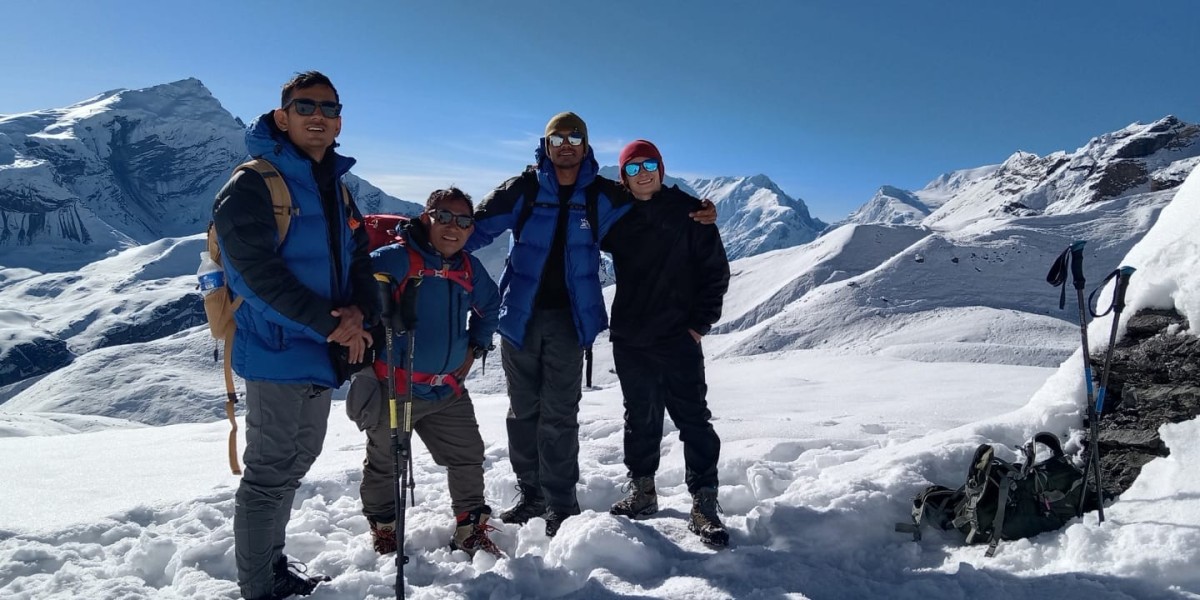Nestled in the heart of the Himalayas, this trek provides an ideal escape from the more frequented trekking routes, allowing for a tranquil exploration of nature's beauty and traditional mountain culture.
The trek begins from Syabrubesi, a small village that serves as the gateway to the Langtang Valley. From the outset, trekkers are enveloped in lush forests of rhododendron and oak, which eventually give way to wide-open meadows and dramatic mountain vistas. The trail follows the Langtang River upstream, leading to the enchanting Langtang Valley, which is surrounded by towering peaks including Langtang Lirung, Ganesh Himal, and the rugged terrain of the Langtang range.
One of the trek’s highlights is the visit to Kyanjin Gompa, a sacred monastery situated at the end of the Langtang Valley Trek. This serene spot offers stunning views of the surrounding peaks and glaciers and serves as a spiritual and cultural center for the local Tibetan-influenced communities. The area around Kyanjin Gompa is dotted with ancient mani walls, prayer flags, and stupas, reflecting the deep spiritual traditions of the region.
The Langtang Valley Trek also includes opportunities for acclimatization and exploration of high-altitude landscapes. Trekking to the viewpoint at Kyanjin Ri or Tserko Ri provides panoramic views of the Langtang Himalaya and a chance to witness the grandeur of the snow-capped peaks up close. These viewpoints offer some of the most spectacular mountain scenery in Nepal, making the effort of reaching them well worth it.
Beyond its natural beauty, the trek offers a chance to experience the local culture and hospitality of the Tamang and Sherpa communities. Traditional stone houses, vibrant prayer flags, and warm interactions with the locals enrich the trekking experience. The trek passes through several charming villages such as Lama Hotel and Mundu, where trekkers can learn about local customs, try traditional dishes, and gain insight into the daily lives of the residents.
The Langtang Valley Trek, with its blend of stunning landscapes, cultural richness, and serene environment, provides a deeply rewarding experience. It is a journey that not only showcases the splendor of Nepal’s natural beauty but also offers a peaceful retreat into the heart of Himalayan culture and spirituality.
Introduction
The Tamang Heritage Trek is a captivating journey into one of Nepal’s most serene and picturesque regions, renowned for its stunning landscapes and rich cultural heritage. Situated in the Langtang National Park, this trek offers a peaceful alternative to the more crowded routes, providing an immersive experience in the heart of the Himalayas. Trekkers are greeted with lush forests, quaint villages, and majestic mountain views, all set against the backdrop of the Langtang range. This trek is ideal for those seeking a blend of natural beauty, cultural interaction, and tranquility. It traverses through diverse terrains, from dense rhododendron forests to high-altitude meadows, leading to the sacred site of Kyanjin Gompa. Here, trekkers are rewarded with panoramic views of the surrounding peaks and the opportunity to engage with the local Tibetan-influenced culture. The Langtang Valley Trek is not only a physical adventure but also a spiritual journey, offering a deep connection with both the environment and the traditional way of life in the Himalayas.
Overview of the Langtang Valley Trek
The Langtang Valley Trek is a moderate trek that typically takes around 7 to 10 days to complete, covering approximately 65 kilometers (40 miles) round-trip. The journey begins in Syabrubesi, a small village that marks the start of the trek, and follows the Langtang River upstream into the heart of the Langtang Valley. The trek leads through a range of landscapes, including lush forests, terraced fields, and alpine meadows, before reaching the scenic Kyanjin Gompa at an elevation of 3,830 meters (12,565 feet). The valley is flanked by impressive peaks such as Langtang Lirung and Ganesh Himal, offering stunning views throughout the trek. Key highlights include the serene environment of Kyanjin Gompa, the opportunity to visit traditional Tibetan-style villages, and the breathtaking panoramas from viewpoints like Kyanjin Ri. The trek is known for its relatively gentle ascent compared to other high-altitude treks, making it accessible to many trekkers who are reasonably fit.
Preparation and Training
Preparation and training are crucial for a successful Langtang Valley Trek, given its moderate difficulty and variable terrain. A structured fitness regimen is essential to build endurance and strength, as the trek involves several days of consistent hiking at altitudes that gradually increase. Cardiovascular exercises such as running, cycling, and swimming, combined with strength training focused on the legs and core, will help in managing the physical demands of the trek. Incorporating hill climbs and long-distance hikes with a loaded backpack into your training routine can simulate the trekking conditions. Additionally, familiarizing yourself with the trek’s elevation profile and altitude challenges will aid in acclimatization. Pre-trek experience with high-altitude trekking is beneficial but not mandatory, as the Langtang Valley Trek is less strenuous than some other Himalayan routes. Proper acclimatization is achieved through a gradual ascent and rest days, ensuring your body adjusts to higher elevations. By preparing physically and mentally, you can enhance your trekking experience and handle the trek’s demands with confidence.
Essential Gear and Packing List
Packing appropriately for the Langtang Gosainkunda lake Trek is vital to ensure comfort and safety throughout the journey. Essential gear includes a well-fitting trekking backpack, durable trekking boots with good ankle support, and layered clothing to adapt to varying weather conditions. The layering system should consist of moisture-wicking base layers, an insulating mid-layer such as a fleece or down jacket, and a waterproof and windproof outer layer. A high-quality sleeping bag rated for cold temperatures and trekking poles can provide additional support and comfort. Other important items include a wide-brimmed hat, sunglasses with UV protection, sunscreen, and a first aid kit stocked with personal medications and altitude sickness remedies. A good water purification system, such as a filter or purification tablets, is necessary for ensuring safe drinking water. It’s also wise to pack energy snacks and a camera or smartphone for capturing the stunning landscapes. Although some gear can be rented in Kathmandu or Pokhara, bringing your own ensures it meets your specific needs and preferences, enhancing your overall trekking experience.
Permits and Documentation
To undertake the Langtang Valley Trek, obtaining the necessary permits and documentation is crucial for a smooth and legal trekking experience. The primary permit required is the Langtang National Park Entry Permit, which is obtained from the park’s headquarters in Dhunche or from the Nepal Tourism Board in Kathmandu. This permit allows trekkers to enter the protected area of Langtang National Park and ensures that park regulations are followed. Additionally, trekkers are required to obtain a TIMS (Trekkers’ Information Management System) card, which is issued by the Trekking Agencies’ Association of Nepal (TAAN) and helps in managing and monitoring trekking activities. Both the Langtang National Park Permit and TIMS card can be arranged through trekking agencies or individually at relevant offices. It is important to carry valid identification, such as a passport with at least six months’ validity, when applying for these permits. Ensuring all permits are in place before starting the trek is essential to avoid any complications and to comply with local regulations.
Travel Arrangements and Logistics
Travel arrangements and logistics for the Gosainkunda lake trek are essential for ensuring a smooth and enjoyable trekking experience. The trek typically begins with a flight into Kathmandu, Nepal's vibrant capital. From Kathmandu, trekkers need to arrange transportation to Syabrubesi, the starting point of the trek. This can be accomplished via a local bus or private vehicle, with the journey taking approximately 7-8 hours, depending on road conditions and traffic. It is advisable to book transportation in advance or coordinate with a trekking agency that can assist with these arrangements.
In addition to transportation, accommodation in Kathmandu should be arranged for before and after the trek. There are numerous hotels and guesthouses catering to trekkers, providing a comfortable base for acclimatization and preparation. After the trek, return transportation to Kathmandu or onward travel should be planned in advance to ensure a smooth transition.
Permits, including the Langtang National Park Entry Permit and TIMS (Trekkers’ Information Management System) card, need to be obtained before starting the trek. These can be arranged through trekking agencies or individually. Engaging a local trekking agency can simplify logistics by handling permits, providing guides, and organizing porters if needed. Proper travel insurance that covers high-altitude trekking and emergency evacuation is also recommended for added security. By ensuring these logistical details are addressed, trekkers can focus on enjoying the Langtang Valley's natural beauty and cultural richness.
Trekking Route and Itinerary
The Langtang Valley Trek generally spans 7 to 10 days, covering around 65 kilometers (40 miles) round-trip. The journey begins in Syabrubesi, with the trek following a well-established route through diverse terrains and scenic landscapes. The standard itinerary often includes the following key segments:
- Day 1: Travel from Kathmandu to Syabrubesi by road. This day serves as a pre-trek preparation and acclimatization period.
- Day 2-3: Trek from Syabrubesi to Lama Hotel, and then to Mundu. The route follows the Langtang River, passing through lush forests and charming villages.
- Day 4-5: Continue to Kyanjin Gompa, the trek’s destination. En route, trekkers can explore traditional villages and enjoy stunning mountain views.
- Day 6: Acclimatization day at Kyanjin Gompa with options to hike to Kyanjin Ri or Tserko Ri for panoramic views.
- Day 7-8: Return trek to Syabrubesi, retracing the route with opportunities to relax and reflect on the journey.
The itinerary is designed to allow for proper acclimatization and exploration of the Langtang Valley’s natural and cultural highlights. This gradual approach ensures a comfortable and enjoyable trekking experience.
Scenic Highlights and Natural Beauty
The Langtang Valley Trek is renowned for its spectacular natural beauty and diverse scenic highlights. The trek begins with lush forests of rhododendron and oak, transitioning into open meadows and alpine landscapes as you ascend. Key scenic highlights include the mesmerizing Langtang range, with peaks like Langtang Lirung and Ganesh Himal providing breathtaking backdrops throughout the journey.
A standout feature of the trek is the area around Kyanjin Gompa, where trekkers are treated to awe-inspiring views of glaciers, snow-capped peaks, and the surrounding high-altitude landscape. From viewpoints such as Kyanjin Ri and Tserko Ri, the panoramic vistas reveal the grandeur of the Himalayas in all their splendor.
The trek also features serene river valleys, cascading waterfalls, and ancient mani walls, enhancing the trek’s visual appeal. The diverse ecosystems encountered along the route, from subtropical forests to rugged alpine terrain, offer a dynamic range of natural beauty, making the Langtang Valley Trek a visually captivating and rewarding experience.
Cultural and Community Experiences
The Short Langtang Valley Trek offers rich cultural and community experiences, providing trekkers with a deep insight into the lives and traditions of the local people. The trek passes through several traditional villages inhabited by the Tamang and Sherpa communities, who have a distinct Tibetan-influenced culture.
Villages such as Lama Hotel, Mundu, and Kyanjin Gompa are key cultural stops where trekkers can observe traditional architecture, including stone houses and monasteries. The local communities are known for their warm hospitality and adherence to traditional practices, including the use of prayer flags, mani walls, and stupas.
Interactions with local residents provide opportunities to learn about their customs, daily routines, and religious practices. The chance to visit monasteries and participate in local festivals, if the timing aligns, further enriches the cultural experience. Sampling traditional dishes, such as dal bhat and momo, and engaging in conversations with villagers enhances the trek’s cultural depth, offering a meaningful connection to the region’s heritage.
Altitude and Acclimatization
Altitude and acclimatization are critical considerations for the Langtang Valley Trek, as the journey reaches elevations of up to 3,830 meters (12,565 feet) at Kyanjin Gompa. Proper acclimatization is essential to prevent altitude sickness and ensure a comfortable trekking experience.
The trek’s itinerary is designed with gradual ascents and built-in acclimatization days, such as the rest day at Kyanjin Gompa. This allows trekkers to adjust to higher altitudes slowly. Symptoms of altitude sickness include headaches, dizziness, and nausea; if experienced, it’s important to seek immediate medical attention and consider descending to a lower altitude.
To aid acclimatization, trekkers should stay well-hydrated, avoid overexertion, and follow a gradual ascent schedule. Physical fitness prior to the trek, including cardiovascular and strength training, can also help the body cope with altitude changes. By adhering to these acclimatization practices and paying attention to the body’s signals, trekkers can manage altitude challenges effectively and fully enjoy the Langtang Valley’s stunning environment.
Daily Trekking Schedule
The Tamang Heritage Trek features a well-paced daily schedule that balances trekking with opportunities for rest and exploration. The trek generally spans 7 to 10 days, with each day carefully planned to cover specific distances and provide time for acclimatization and sightseeing.
On the first day, trekkers travel from Kathmandu to Syabrubesi, which serves as the trek’s starting point. The following days involve a steady ascent through varied terrains. From Syabrubesi, the trek typically progresses to Lama Hotel on the second day, covering approximately 6 to 7 hours of hiking. The third day involves a trek from Lama Hotel to Mundu, which continues through lush forests and charming villages.
Days four and five are dedicated to reaching Kyanjin Gompa, the trek’s highlight. The ascent to Kyanjin Gompa takes around 5 to 6 hours, allowing trekkers to explore the area’s unique landscapes and cultural sites. An acclimatization day is usually included at Kyanjin Gompa to hike to viewpoints such as Kyanjin Ri or Tserko Ri, offering stunning panoramas of the Langtang range.
The return journey retraces the route, with days six through eight spent descending to Syabrubesi. This segment allows for reflection on the trek and additional opportunities to interact with local communities. The final day typically involves travel back to Kathmandu, completing the trek.
The daily trekking schedule is designed to ensure proper acclimatization and enjoyment, with ample time allocated for both trekking and relaxation.
Accommodations and Meals
Accommodations on the Langtang Gosainkunda lake Trek are primarily provided in teahouses, which offer basic yet comfortable lodging along the route. These teahouses typically feature simple rooms with twin beds and shared facilities. The level of comfort can vary, but they generally provide a cozy and welcoming environment for trekkers.
Meals are served at the teahouses and include a variety of traditional Nepali and Tibetan dishes. Breakfast usually consists of options like eggs, toast, porridge, and tea. For lunch and dinner, trekkers can enjoy hearty meals such as dal bhat (rice with lentil soup), momo (dumplings), and noodle soups. The menu may be somewhat limited at higher altitudes, but the focus remains on providing nutritious and satisfying food.
While teahouses generally cater well to trekkers, it’s advisable to bring some high-energy snacks for additional sustenance. The communal dining areas at teahouses offer opportunities to interact with fellow trekkers and share stories, adding a social dimension to the trek. Overall, the combination of comfortable accommodations and nourishing meals enhances the trekking experience, allowing trekkers to focus on enjoying the journey.
Weather and Climate Considerations
Weather and climate play a significant role in the Gosainkunda lake Trek, influencing both the comfort and safety of the journey. The trek is most commonly undertaken during the pre-monsoon (March to May) and post-monsoon (September to November) seasons, which offer the best weather conditions. During these periods, the weather is generally stable, with clear skies and moderate temperatures.
Daytime temperatures in the lower elevations typically range from 10°C to 15°C (50°F to 59°F), while temperatures at higher altitudes can drop significantly, especially at night. At Kyanjin Gompa and higher elevations, temperatures can fall below freezing. Trekking during the monsoon season (June to August) or winter (December to February) is less ideal due to heavy rains and snow, which can create challenging conditions and potential hazards.
Trekkers should be prepared for variable weather, including potential rain, snow, and strong winds. Packing layers of clothing, including thermal base layers, a good quality waterproof jacket, and an insulated sleeping bag, is essential. Monitoring weather forecasts and being prepared for sudden changes can help manage weather-related challenges and ensure a more comfortable trekking experience.
Health and Safety Precautions
Health and safety are crucial aspects of the Langtang Valley Trek 8 Days due to the trek’s high-altitude nature and physical demands. Proper acclimatization is essential to prevent altitude sickness, which can occur at elevations above 2,500 meters (8,200 feet). Symptoms of altitude sickness include headaches, nausea, and dizziness. To minimize the risk, trekkers should follow a gradual ascent schedule, take rest days as needed, and stay hydrated.
A well-stocked first aid kit, including personal medications and altitude sickness remedies, is important for addressing any health issues. Travel insurance that covers high-altitude trekking and emergency evacuation is also highly recommended for added security.
Good hygiene practices, such as using purified water and consuming well-cooked food, help prevent gastrointestinal problems. Trekkers should also be mindful of their physical limits, avoiding overexertion and ensuring adequate rest. By adhering to these health and safety precautions, trekkers can enjoy the Langtang Valley Trek with greater confidence and peace of mind.
Tips for a Successful Trek and Final Reflections
To ensure a successful langtang Valley Trek 7 days, careful preparation and a positive mindset are key. Begin with physical conditioning, incorporating cardiovascular exercises, strength training, and long hikes into your routine to build stamina and endurance. Familiarizing yourself with the trek’s elevation profile and itinerary will help in managing the trek’s demands effectively.
Packing wisely is crucial; include layered clothing, sturdy trekking boots, a high-quality sleeping bag, and trekking poles. Additionally, bring personal essentials such as a water purification system, sunscreen, and a camera to capture the stunning scenery.
Engaging a reputable trekking agency can simplify logistics, including obtaining permits and arranging guides or porters. Respect local customs and practices, and engage with the community to enrich your cultural experience. Staying flexible and maintaining a positive attitude will help in navigating any unforeseen challenges and making the most of the trek.
In final reflections, the Langtang Valley Trek offers a deeply rewarding experience, combining natural beauty with cultural immersion. By preparing thoroughly and embracing the journey, trekkers can create lasting memories and gain a profound appreciation for the serene and splendid landscapes of the Langtang region.









